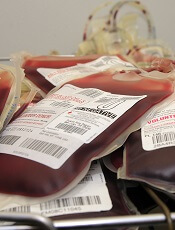
Credit: UAB Hospital
Results of a retrospective study suggest an antifibrinolytic agent can significantly reduce the need for blood transfusions after surgery, without increasing the risk of complications.
The agent, tranexamic acid, has been shown to reduce blood loss during or shortly after major joint surgery, but safety concerns remain because large-scale effectiveness studies are lacking.
So researchers set out to evaluate tranexamic acid in a large sample of surgical patients.
The team recounted their efforts in BMJ.
Stavros Memtsoudis, MD, PhD, of the Hospital for Special Surgery in New York, New York, and his colleagues analyzed data from 872,416 patients who underwent total hip or knee replacement procedures at 510 US hospitals between 2006 and 2012.
The researchers compared patients who received tranexamic acid (at 1000 mg,
2000 mg, or 3000 mg) on the day of surgery to patients who did not. The team adjusted their analysis for factors such as patient age and sex, hospital size and location, the type of procedure, and the anesthesia used.
Results showed that use of tranexamic acid was associated with an up to 69% reduction in the need for blood transfusions. Overall, the rate of allogeneic or autologous transfusion was 7.7% among patients who received tranexamic acid and 20.1% among those who did not (P<0.01).
Tranexamic acid use was also linked to a decreased risk of all complications (1.9% vs 2.6%, P<0.001), thromboembolic events (0.6% vs 0.8%, P=0.0057), the need for mechanical ventilation (0.1% vs 0.2%, P=0.0003), and admission to an intensive care unit (3.1% vs 7.5%, P<0.001).
The median length of hospital stay was the same for treated and untreated patients—3 days. But the median cost of hospital stay was lower among tranexamic acid-treated patients—$14,890 vs $15,110 (P<0.001).
A tranexamic acid dose of 2000 mg appeared to have the best effectiveness and safety profile. But the researchers said additional studies are needed to establish optimal dosing schemes and assess subgroup-specific effectiveness and safety.

